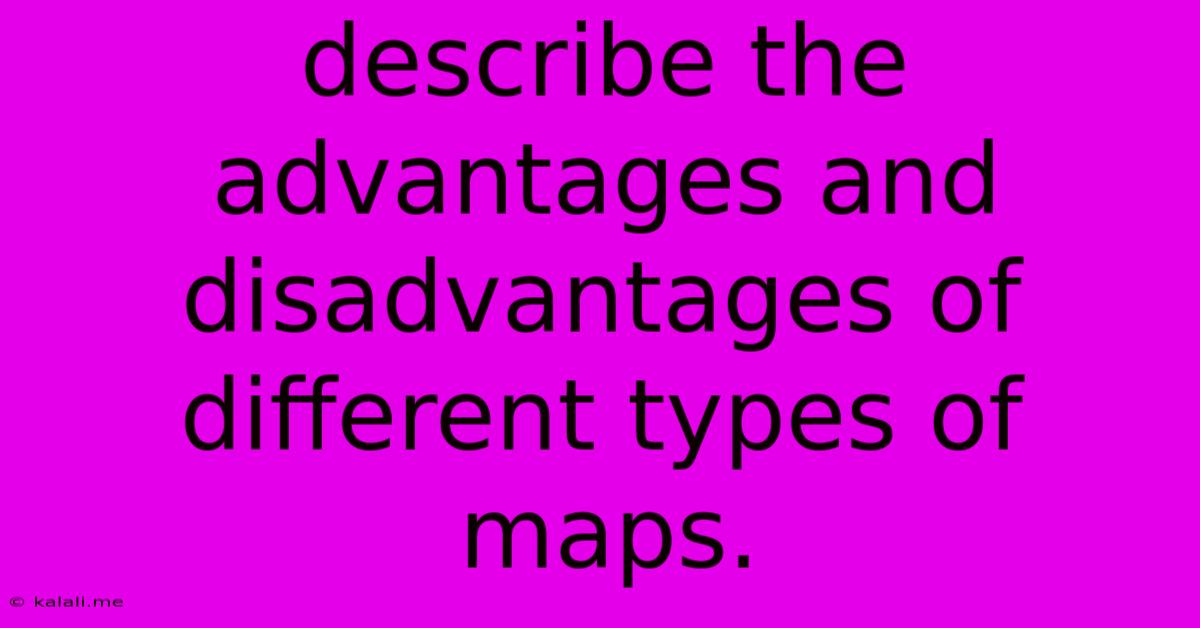Describe The Advantages And Disadvantages Of Different Types Of Maps.
Kalali
Jun 15, 2025 · 4 min read

Table of Contents
Advantages and Disadvantages of Different Types of Maps
Choosing the right map for your needs depends heavily on the information you're trying to convey and the audience you're targeting. Different map types excel in highlighting specific data, but each comes with its own set of limitations. This article explores the advantages and disadvantages of several common map types, helping you make informed decisions for your next project.
What are the different types of maps? This article will focus on some of the most widely used map types: road maps, topographic maps, thematic maps, satellite imagery maps, and online maps.
Road Maps
Advantages:
- Easy Navigation: Road maps are designed for straightforward navigation, clearly displaying roads, highways, and major landmarks. Finding your way from point A to point B is simple and intuitive.
- Wide Availability: Road maps are readily available in print and digital formats, making them easily accessible.
- Offline Access: Printed road maps offer offline access, eliminating reliance on internet connectivity.
Disadvantages:
- Limited Detail: Road maps prioritize road networks, often omitting details about terrain, elevation, or other geographical features.
- Outdated Information: Printed road maps can quickly become outdated, especially in rapidly changing areas.
- Lack of Contextual Information: They generally lack information beyond basic road networks, limiting their usefulness for detailed planning or analysis.
Topographic Maps
Advantages:
- Detailed Terrain Representation: Topographic maps show elevation changes using contour lines, providing a three-dimensional representation of the land surface. This is crucial for activities like hiking, climbing, or land surveying.
- Precise Location Information: These maps provide precise location information and allow for accurate measurements of distance and elevation.
- Useful for various purposes: They serve a variety of purposes beyond hiking and climbing. They are used by engineers, geologists and for urban planning.
Disadvantages:
- Complexity: The use of contour lines can be challenging for those unfamiliar with topographic map conventions.
- Limited Thematic Information: Topographic maps primarily focus on terrain; other data like population density or land use is often absent.
- Scale Limitations: The level of detail is often limited by the map's scale; larger scale maps show more detail but cover a smaller area.
Thematic Maps
Advantages:
- Highlight Specific Data: Thematic maps excel in visualizing specific data, such as population density, climate patterns, or disease outbreaks. They provide a clear and concise representation of a chosen topic.
- Effective Communication: They can communicate complex information effectively using visual cues like colors, symbols, and patterns.
- Versatile Applications: They are used across a vast array of fields including environmental science, epidemiology, and socio-economic analysis.
Disadvantages:
- Data Bias: The chosen data and the way it’s presented can introduce bias, impacting the interpretation of the map.
- Map Design Challenges: Creating an effective thematic map requires skill in cartography and data visualization to avoid misleading interpretations.
- Limited Spatial Detail: Depending on the scale and data aggregation, thematic maps might lack detail at a local level.
Satellite Imagery Maps
Advantages:
- High-Resolution Imagery: Satellite imagery maps offer high-resolution images of the Earth's surface, providing detailed visual information.
- Real-time Updates: Many services provide near real-time updates, showcasing recent changes in landscapes or infrastructure.
- Wide Area Coverage: Satellite imagery allows for the coverage of vast areas, making it ideal for regional or global-scale analysis.
Disadvantages:
- Cost: Access to high-resolution satellite imagery can be expensive.
- Data Interpretation: Interpreting satellite imagery can require specialized knowledge and skills.
- Cloud Cover: Cloud cover can obstruct views, limiting the usefulness of the data at certain times.
Online Maps (e.g., Google Maps)
Advantages:
- Interactive Features: Online maps offer interactive features like zooming, panning, and street view, providing a highly immersive experience.
- Real-time Updates: Many online map services integrate real-time traffic, weather, and other dynamic data.
- Integration with Other Services: They often integrate with other services, enabling location-based searches, directions, and more.
Disadvantages:
- Internet Dependency: Access requires a reliable internet connection.
- Data Accuracy: The accuracy of data can vary depending on the provider and the level of detail.
- Privacy Concerns: The collection and use of location data raise privacy concerns.
Ultimately, the "best" type of map is the one that best suits your specific needs and objectives. Consider the information you want to convey, the level of detail required, and your audience's familiarity with different map types when making your selection.
Latest Posts
Latest Posts
-
What Is The Multiple Of 15
Jun 16, 2025
-
Histones Are Proteins Associated With Which Of The Following
Jun 16, 2025
-
Who Is The First Woman Prime Minister In The World
Jun 16, 2025
-
Stress Strain Curve Ductile Vs Brittle
Jun 16, 2025
-
What Is The Distance Between Rarefactions Called
Jun 16, 2025
Related Post
Thank you for visiting our website which covers about Describe The Advantages And Disadvantages Of Different Types Of Maps. . We hope the information provided has been useful to you. Feel free to contact us if you have any questions or need further assistance. See you next time and don't miss to bookmark.